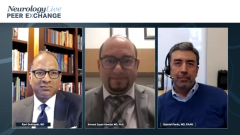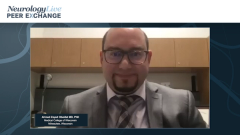
Generic Disease-Modifying Therapies (DMTs) in RRMS
Expert neurologists review availability of generic disease-modifying therapies [DMTs] and the effectiveness of reduced cost to the patient with RRMS
Episodes in this series

Ahmed Zayed Obeidat MD, PhD: One of the things you mentioned is cost effectiveness, and that brings us to generics. One of the main reasons we have generics is to cut cost. We’ll talk a bit about how long we’ve had those available and what ones are coming from those generics. I’ll start with you, Dr Pardo, since you talked about cost effectiveness, and then Dr Dukkipati will talk about it next.
Gabriel Pardo, MD, FAAN: Sure. The approval by the FDA of the first generic was dimethyl fumarate in September 2020. I think we started seeing it in the market in early 2021, at least in our area. Since then, we have had several other ones that have become generic. We have glatiramer acetate, fingolimod, and teriflunomide that have become generic. All of these, including glatiramer acetate, are considered generics in that they are essentially chemical components, even though glatiramer acetate is a polymer, but it is not considered a biologic as such. So, it still falls within the category of generics, which is different from biosimilars, which we will perhaps also have in MS [multiple sclerosis] in the future, even perhaps later this year. But we do not have biosimilars quite yet. That would imply that we’re talking about a biologic compound, essentially a protein that has a higher level of complexity, in the production of such a type of medication. Those are the ones that we have seen come to market in the area of multiple sclerosis.
To your point about cost effectiveness, you’re absolutely right that, in general when we think of generic medications, the vast majority of prescriptions that are filled in the United States, not just in MS but in total, 80% or so is a generic. So, it is not a new thing to medicine, it’s new to MS. But I think that one of the important aspects behind generics is the cost-saving aspect to it because of course when a manufacturer is producing a generic, they have not had to invest in the research and development of the medication. They do not have to do a lot of marketing. All that has been done by the branded product for a very long time. Theoretically you are going to be able to come to market at a lower cost, and the competition also is going to lower the cost. Unfortunately, in the area of MS, that has not translated into savings for the patient. I think one of the most important things we need to [consider] is, is it saving the system some money? It’s possible. But is the ultimate consumer, the patient, really receiving that benefit? I don’t think that’s the case, and it will be important to explore that aspect.
Ahmed Zayed Obeidat MD, PhD: These are great points. I think when an innovator drug comes in and then there’s a copy, which is a generic, which is literally a copy of the innovator drug, right? Then when that comes to market, it hasn’t gone through multiple clinical trials, all the investment that the innovator drug has done, and we expect to have savings in the cost. Dr Dukkipati, what do you think about this aspect in particular, and about the cost saving to patients, and what they may be losing or gaining from a generic drug compared to the brand drug?
Ravi Dukkipati, MD: Sure. I think we will be elaborating further on the difference between generic and biosimilar because there are some distinct differences, but let’s address generics first. As Dr Pardo pointed out, we’ve had generic versions of glatiramer acetate, dimethyl fumarate, teriflunomide, and fingolimod most recently. And to Dr Pardo’s point, unlike other disease spaces, the cost savings and such have not been translated as directly to the patient as they have in other disease states.
The other important distinction to make is when you or I go to the pharmacy and pick up a generic antibiotic or a generic, I will say a simple drug, the consequences are not the same in the sense that you take the antibiotic, you feel better, and you move on. Multiple sclerosis, it goes without saying, is a much more complex disease process, and I think a generic MS drug should be viewed and treated differently from a generic simple drug. For reasons beyond the discussion here today and that includes payers, insurance companies, and other entities, for whatever reason, in disease spaces like multiple sclerosis, these so-called cost savings are not being realized by the patient. They’re being realized by other entities, and ultimately the cost of these drugs is not as dramatically different, that is generic compared to branded drugs.
The one point I want to make is while these generic manufacturers do not have to invest in preclinical studies, marketing, and what have you, there’s also the patient support component. Back to the comparison I made between antibiotics and MS treatments, treatments for MS are not solely taking the pill and moving on with one’s day. There’s a lot more involved, and we can’t discount the role that patient support services by the branded manufacturers have played in terms of partnering in care, which also ties back to what we were talking about earlier, and that is access, engagement, compliance, and follow-up, etc.
Ahmed Zayed Obeidat MD, PhD: Yes, and I can’t agree more also because some of the benefits, sometimes a patient’s insurance can have lapses. A patient may have a change in their job, or they lose their job, and then they have an insurance gap. Sometimes if they are on a branded medication with patient support services, they can get a bridge until they get back to insurance or get something covered, so they’re not left without any disease-modifying therapy. These are some of the benefits that may be lost with a generic drug, and maybe you need the manufacturer of the generics to think about those. As we get the generic to the market, bring with it the patient support program. That’s one of the things that may be important to do.
Ravi Dukkipati, MD: Another factor, and this I believe varies from state to state, and from one insurance plan to another insurance plan, is the co-pays and deductibles. What we’ve seen here is, once again from a patient perspective, generics are not necessarily cheaper because what happens is without the patient support programs, and co-pay assistance programs, at the end of the day, when a patient is switched to a generic, their out-of-pocket expenses are higher.
Ahmed Zayed Obeidat MD, PhD: We’ve seen it practice in several cases. Then sometimes the patient says, “I’m not going to take this medicine anymore.” So, we’re forced to switch classes sometimes because we don’t have the ability to get them on the brand name medication.
Transcript edited for clarity
Newsletter
Keep your finger on the pulse of neurology—subscribe to NeurologyLive for expert interviews, new data, and breakthrough treatment updates.
































